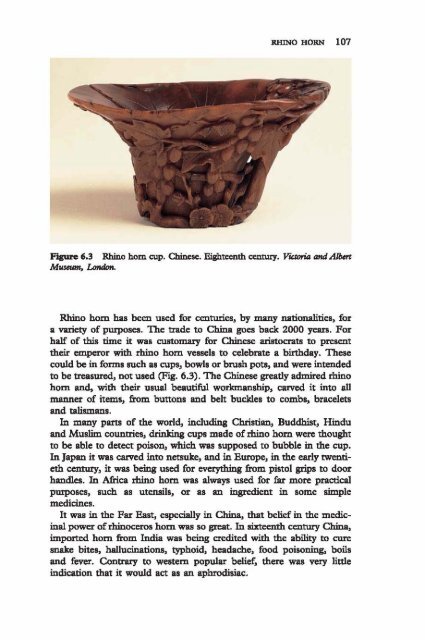- Page 1:
Gem and OrnamentalMaterials of Orga
- Page 6 and 7:
Contents
- Page 8:
Introduction
- Page 13 and 14:
Photo credits
- Page 18 and 19:
AMBER AND COPAL 3Figure 1.1-Insect
- Page 20 and 21:
AMBER AND COPAL 5F M1.5 Poorly pres
- Page 22:
AMBHR AND COPAL 7Figure 1.7 Piece o
- Page 25 and 26:
10 GEMS AND ORNAMIWTAL MATBEUAZS OF
- Page 27 and 28:
12 GEMS AND ORNAMENTAL MA- OF ORGAN
- Page 29:
14 GaMs AND ORNAMENTAL ~~ OF ORGANI
- Page 35 and 36:
20 GHMS AND ORNAMlNTAL MATBRIAIS OF
- Page 37 and 38:
22 GEMS AND ORNAMHNTAL MATERMIS OF
- Page 39 and 40:
24 GEMS AND ORNAMENTAL MATERIMS OF
- Page 44:
AMBER AND COPAL 29Figure 1.34 Piece
- Page 50 and 51:
AMBER AND COPAL 35- - -Figure 1,37
- Page 52:
Figure 1.39 Amber and ivmy casket,
- Page 55 and 56:
40 GEMS AND ORNAMHNTAL MATERMIS OF
- Page 57:
42 GEMS AND ORNAMENTAL MATBElIALS O
- Page 60 and 61:
F I 2.6 Jet simuht showing uneven c
- Page 62:
Figure 2.9Vulcanite chain linlc whi
- Page 66 and 67:
Figure 2,12tesLJet simulant bead, a
- Page 69: 54 GaMs AND ORNAMENTAL ~~ OF ORGANI
- Page 73 and 74: 58 GaMs AND ORNAMENTAL MIXRIMS OF O
- Page 77: The fedes dso any tu& though theirs
- Page 80: mything hm fish and birds to the la
- Page 85 and 86: 70 GEMS AND ORNAMHNTAL MATERIALS OF
- Page 88: Figure 3.9'Ivorine' plah he&, imimt
- Page 91 and 92: +Even,76 GEMS AND ORNAMWTAL MA- OF
- Page 95 and 96: 80 GBMs AND ORN-AL MATERMIS OF ORGA
- Page 100: 4 Bone
- Page 103 and 104: 88 GEMS AND ORNAMWTAL MA- OF ORGANI
- Page 108 and 109: 5 Antler
- Page 113 and 114: Figure 5*3 Tupilakof reindeer antle
- Page 117 and 118: 6 Rhino horn
- Page 119: 104 GaMs AND ORNAMHNTAL MATERMIS OF
- Page 126 and 127: HORN 111
- Page 128: Figme 7.4Various modem horn items.F
- Page 132 and 133: ~igare 7.8 Hmn s m m m under mad-po
- Page 135 and 136: aq ppo g 'my1103 3emdmw Po02 ta apt
- Page 138: Figure 7.13 Horn p d t by Mme Bone.
- Page 141 and 142: 126 GEM AND ORNAMENTAL MATERMU OF O
- Page 144 and 145: Greens me larger than hawksbills an
- Page 146 and 147: Figure 8.8w=.Detail of pmsed card c
- Page 148 and 149: Figure 8.11 Tomkhell dressing table
- Page 150: Figure 8.13colour .Plastic imimtiug
- Page 157 and 158: 9 Pearl
- Page 160 and 161: Figure 9.2 Broken blister pearl in
- Page 163 and 164: America. The pearls were plentiful,
- Page 165 and 166: 150 GHMs AND 0-AL MA- OF ORGANIC OR
- Page 167: 152 GEMS AND OKNAMENTAL ~~ OF ORGAN
- Page 170 and 171:
Figure 9,12 DyedChinese &&waterpear
- Page 172 and 173:
masn q~w q ma^ umqmd pamapnu pamp n
- Page 175 and 176:
Figure 9,17Cultured pearl, ahowing
- Page 178:
Figure 9.22Coated p hk bead with wo
- Page 184:
10 Shell
- Page 187 and 188:
Figure 10.2Cowrie ahells: natural a
- Page 190 and 191:
Figure 10.5Three opercula (magn5ed)
- Page 193 and 194:
178 GEMS AND ORNAMENTAL MAlXRlMS OF
- Page 195 and 196:
180 GaMs AND ORNAMHNTAL MATBRIALS O
- Page 197 and 198:
of the shell is lost. It is usually
- Page 199:
184 GHMs AND ORNAMENTAL MATERIALS O
- Page 202:
××
- Page 207:
11 Coral
- Page 211 and 212:
Tlis order covers soft corals, but
- Page 213 and 214:
198 GBMs AND ORNAMENTAL MATBRIALS O
- Page 215 and 216:
200 G W AND ORNAMENTAL MATERIMS OF
- Page 217 and 218:
202 G W AND ORMAMENTAL MA-OF ORGANI
- Page 219 and 220:
204 GEMS AND OKNAMENTAL MATERIMS OF
- Page 221 and 222:
206 GHhZs AND ORNAMENTAL MllRUU OF
- Page 225 and 226:
210 GaMs AND ORN-AL MATERIM3 OF ORG
- Page 227:
212 GaMs AND ORN-AL MATERIAIS OF OR
- Page 234 and 235:
12 Miscellaneous organics
- Page 237:
222 GEMS AND 0-AL MA- OF ORGANIC OR
- Page 243 and 244:
Figure 12.5 Chinme lacquer brooch (
- Page 245 and 246:
Figure 12.8Vegetable ivorg structur
- Page 248 and 249:
MIScELIANROUS ORGANICS 233Figme 12.
- Page 250:
Figum 12.12 Two demtive cups of osi
- Page 256 and 257:
Figare 13,lShellac Union case.Shell
- Page 259 and 260:
244 GEMS AND OKNAMENTAL MATERIMS OF
- Page 261:
246 GaMs AND 0-AL MATERIMS OF ORGAN
- Page 271:
Glossary×
- Page 277 and 278:
This Page Intentionally Left Blank



